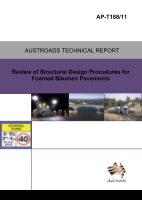Pavement

Review of Structural Design Procedures for Foamed Bitumen Pavements
- Publication no: AP-T188-11
- ISBN: 978-1-921709-89-0
- Published: 10 August 2011
- PDF (free) Download
This report presents a review of the available structural design methods for foamed bitumen pavements, as a first step in the development of thickness design procedures. Six design procedures were found in the literature, most of them based on well known pavement design methods (e.g. South African Mechanistic Design Method, Austroads, United Kingdom Transportation Research Laboratory) with some variations to accommodate the observed or assumed behaviour of foamed bitumen pavements into the pavement design. The last part of the report summarizes the design methods an presents a case study in which the rehabilitation of one granular pavement was designed using the six design methods.
- 1. INTRODUCTION
- 1.1. Project Background
- 1.2. Overview of the Report and Design Procedures
- 2. SOUTH AFRICAN TG2 2002 DESIGN METHOD
- 2.1. Background
- 2.2. Observed Behaviour of Foamed Bitumen Pavements
- 2.2.1. Field Observations from Accelerated Pavement Testing
- 2.2.2. Laboratory Observations
- 2.3. TG2 2002 Thickness Design Method
- 2.3.1. Effective Fatigue Phase
- 2.3.2. Equivalent Granular Phase
- 2.4. Classification of the Foamed Bitumen Mixes
- 3. METHODS BASED ON AUSTROADS DESIGN GUIDELINE
- 3.1. Background
- 3.2. Department of Transport and Main Roads, Queensland
- 3.2.1. Design Equation
- 3.2.2. Other Pavement Design Considerations
- 3.2.3. Minimum Surface Requirements
- 3.3. City of Canning
- 3.3.1. Background
- 3.3.2. Development of Fatigue Equation
- 3.3.3. Other Design Considerations
- 3.3.4. Minimum Surface Requirements
- 3.4. NZ Transport Agency Method
- 3.4.1. Background
- 3.4.2. Design Inputs and Distress Models
- 4. Knowledge-based TG2 2009 structural design method
- 4.1. Background
- 4.2. Concepts in the Development of the Pavement Number
- 4.2.1. The Effective Long-term Stiffness (ELTS)
- 4.2.2. Characterisation of Subgrade Materials
- 4.2.3. The Modular Ratio Limit Concept
- 4.2.4. Assumed Behaviour of Bitumen Stabilised Layers
- 4.2.5. Base Confidence Factor
- 4.3. Calculation of PN
- 4.4. Design Criteria PN Model
- 4.4.1. Allowed Capacity
- 4.4.2. Minimum Surface Requirements
- 5. TRANSPORTATION RESEARCH LABORATORY
- 5.1. Background
- 5.2. Design Procedure
- 5.2.1. Road Type Categories
- 5.2.2. Foundation Class
- 5.2.3. Classification of Foamed Bitumen Mixes and Design Chart
- 5.2.4. Minimum Surface Requirements
- 6. COMPARISON OF PAVEMENT DESIGNS
- 6.1. Summary of Design Methods
- 6.2. Case Study
- 6.2.1. Description of the Example Project
- 6.2.2. TG2 2002 Design
- 6.2.3. Department of Transport and Main Roads, Queensland Design
- 6.2.4. City of Canning Design
- 6.2.5. NZ Transport Agency Design
- 6.2.6. Transportation Research Laboratory (TRL) Design
- 6.2.7. Knowledge-based TG2 2009 Design
- 6.2.8. Summary of Designs and Discussion
- 7. INTERIM PROCEDURE FOR THE THICKNESS DESIGN OF FOAMED BITUMEN PAVEMENTS
- 7.1. Introduction
- 7.2. Minimum Stiffness Requirements
- 7.3. Temperature Adjustment
- 7.4. Rate of Loading Adjustment
- 7.5. Fatigue Criteria
- 7.6. Minimum Surface Requirements
- 8. SUMMARY, CONCLUSIONS AND RECOMMENDATIONS
- 8.1. Review of Design Methods
- 8.2. Comparison of Pavement Designs
- 8.3. Recommendations
- REFERENCES
- APPENDIX A ADJUSTMENT FACTORS FOR THE TG2 2009 THICKNESS DESIGN METHOD
- APPENDIX B DETAILS OF THE THICKNESS DESIGN OF FOAMED BITUMEN PAVEMENTS
- APPENDIX C INTERIM DESIGN PROCEDURE FOR FOAMED BITUMEN PAVEMENTS
- APPENDIX D DESIGN EXAMPLE USING INTERIM DESIGNPROCEDURE
Related publications
Latest Pavement News
